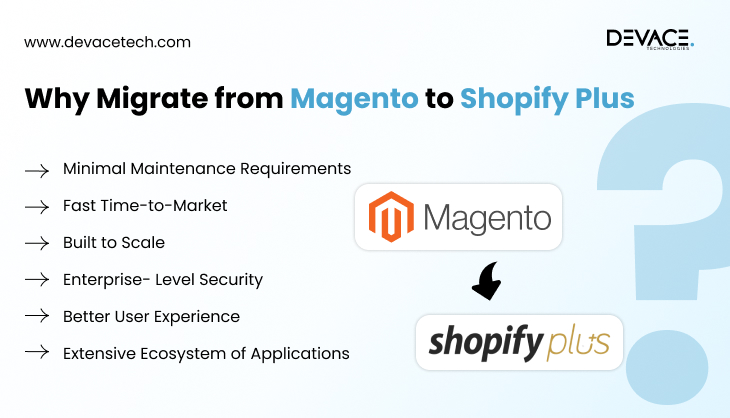Are you thinking of switching to the Shopify Plus platform? This guide walks you through the detailed process and everything else you need to know.
The latest advancements in eCommerce shopping are pushing businesses to adopt platforms that are scalable and support user-friendly interfaces. Although Magento is a powerful option, it can be complex and resource-intensive to maintain. That’s why many brands are turning to Shopify Plus. It’s a cloud-based, fully hosted platform and built to cater to high-volume merchants.
This comprehensive blog will tell you about all the details of the entire Magento to Shopify Plus migration process.
Why Migrate from Magento to Shopify Plus?
Here are the key reasons behind migrating to Shopify Plus:

1. Minimal Maintenance Requirements
Although companies utilize Magento website builder for developing sites to run everything smoothly, Magento needs regular version updates, patches, a team of skilled developers, and hands-on server management. On the other hand, Shopify Plus is a completely managed SaaS platform. It takes care of everything from security and hosting to software updates.
Are you facing difficulties in switching to Shopify Plus?
2. Fast Time-to-Market
It can take weeks to develop and launch features for Magento because of its dependence on skilled developers and complexity. In contrast, the intuitive interface and app marketplace of Shopify Plus enable faster feature developments and store updates. Even if you compare Shopify vs Shopify Plus, the latter one is way faster.
3. Built to Scale
Over 10000 transactions per minute are handled by Shopify Plus, making it the best fit for peak traffic and flash sales. Without requiring any additional infrastructure, the elastic architecture of Shopify Plus ensures consistent performance.
4. Enterprise- Level Security
To maintain PCI compliance and implement security measures Magento stores need developers’ expertise and third-party tools. On the other hand, Shopify Plus is PCI-DSS compliant and includes fraud analysis, high-scale protection, and SSL certification.
5. Better User Experience
The admin dashboard of Shopify is beginner-friendly and clean. It is easy to use, and employees of different departments such as sales, inventory, and marketing can easily handle and navigate it without having any technical training.
6. Extensive Ecosystem of Applications
Thousands of plugins and vetted apps are featured by Shopify Plus stores, improving your online performance. From CRM integration and email marketing to upselling tools and shipping automation, you can play and plug in with minimal setup. Moreover, if you face some difficulties in shifting your store to Shopify Plus, you can avail Magento to Shopify Plus migration services for a smooth process.
Some Pre-Migration Considerations
Even before starting the migration from Magento to Shopify Plus, it’s important to have a solid foundation to ensure that nothing critical is overlooked and the complete process goes smoothly. Here are some pre-migration things that you should consider:
Audit your current store
Thoroughly review your existing Magento store. Identify all the key elements and data you want to migrate- pricing, variants, SKUs, customer accounts, media, order history, and products. In the longer run, it will assist in mapping Shopify Plus solutions after migration is completed.
Set Goals and Priorities
Define what you want to gain with Shopify Plus such as better experience for shoppers, streamlined workflows, better mobile experience, faster performance, and other goals as well. The priorities are what you need to achieve first.
Cater SEO Preservation
You may have achieved your SEO rankings in years; you can preserve these rankings and traffic post-migration by making a detailed list of metatags, Magento URLs, and schema markup. Then by also plan to redirect them.
Budget and Timeline Estimation
Keep your budget for the migration process in mind as it includes costs of design and development, professional services, third-party tools, and app charges. Also, define the timeline you allocate to switching to your new platform.
Magento to Shopify Plus Migration: Step-by-Step Process
Let’s get into the whole Magento to Shopify Plus migration process and learn how to carry out each step involved:

Step 1: Magento Store Backup
Start by creating a full backup of your Magento store including custom code, media files, and database. This backup will save you in case anything goes wrong and help you revert to your original setup.
Step2: Setting up Shopify Plus
In the next step, sign up for your Shopify Plus plan subscription and start by setting up your account. Once you successfully set up your account, configure all your core settings including user accounts, payment methods, your domain, shipping preferences, and tax rules.
If you hire expert Shopify developers, they can assist you in having smooth access to the latest features like Script Editor, Launchpad, and Shopify Flow.
Step 3: Building or Selecting Shopify Theme
You can either select a pre-built theme available on the Shopify Theme Store or get a developer on board to recreate your Magento store style with the help of the Liquid templating engine of Shopify. This way you can not only improve mobile responsiveness and UX but also your e-store’s look and feel.
Step 4: Migrating Store Data
When you are done with a suitable theme selection, migrate your store’s data by using certain migration tools such as Matrixify, Cart2Cart, or LitExtension. It includes:
- Collection and categories
- Brand products (with pricing, SKUs, and images)
- Client accounts with passwords
- Discount codes and reviews
- Invoices and order history
Pro Tip: First, run a test migration and then before proceeding for a full migration, validate the data.
Step 5: Configuring SEO and URL Redirects
With Shopify Plus you can manually add URL redirects or through bulk CSV import. Also, replicate your meta titles, descriptions, custom tags, and image alt text in Shopify. So that you can maintain your search engine rankings.
Step 6: Installing Apps and Integrations
Now, install those applications that are compatible with Shopify Plus for shipping, CRM, analytics, and marketing. If you were previously using Magento-specific extensions, now with Shopify Plus explore alternative apps and extensions.
Step 7: Testing Everything
Before launching your store online test your store thoroughly including:
- UX and navigation
- Integration of payment gateways
- Analytics and conversion tracking
- Product pages
- Add to cart functions and smooth checkout
Step 8: Going Live
After conducting the test run successfully, pick a time to go live when online traffic is less. For directing to your new Shopify store, update your domain DNS settings. To address any post-launch issue, actively monitor your site for the next 24-48 hours.
Common Pitfalls and How to Avoid Them
Have a look at the given table to see what issues you might face during Magento to Shopify Plus migration and how to fix them:
| Issue | Fix |
| Duplication or Data Loss | Utilize tools with data validation |
| Design Issues | Emphasize creating core branding |
| SEO Drop and Broken URLs |
Submit new sitemap to GSC 301 redirects Recreate metadata |
| Limitations with Apps | Avail expert assistance |
Some Important Tools for Smooth Migration
- Shopify Flow: Suitable for automating order tags, emails, and inventory
- LitExtension: Reliable data transfer and automation
- Cart2Cart: 24/7 support and the best fit for brands with complex databases
- Rewind Backups: Ensure backups
- Matrixify: Advanced tool for data import and export
Post Migration Checklist
Do not forget to mark this checklist while migrating to Shopify Plus:
- Once you go live, make sure you are taking care of everything enlisted below:
- Confirm all URLs and redirects are functioning
- You resubmit your sitemap to Google Search Console
- Retest checkout process and mobile responsiveness
- Reconfigure conversion tracking and analytics
- Submit structured data and reindex product pages
- Evaluate performance and fix bugs rapidly
Wrapping Up
It’s a completely strategic move to shift from Magento to Shopify Plus. This can streamline your business operations, improve eCommerce infrastructure, and foresee brand growth. You can have a smooth transition by planning the whole process, choosing the right tools, and consulting Shopify Plus migration experts.
Are you looking for a reliable migration partner?
FAQs
1. Why should I consider migrating from Magento to Shopify Plus?
To have simple store management, better scalability, and minimal maintenance costs, you can migrate your online store to the Shopify Plus platform.
2. Is Shopify Plus the right fit for large-scale eCommerce stores?
Yes, absolutely Shopify Plus is designed for high-growth brands. It offers enterprise-level features like APIs and dedicated account managers, integrates easily with CRMs and ERPs, and supports high-volume sales.
3. What are the key steps of Shopify Plus migration?
Shopify Plus migration key steps include data backup, Shopify Plus configuration, migrating client and product information, SEO redirects setup, installing applications, conducting thorough testing, and launching your e-store.
4. Is it possible to migrate the Magento store design to Shopify Plus?
Due to platform differences, direct-theme migrations are not possible. However, it’s possible to redesign a similar version of the previous one.
5. How long does the whole migration process take?
On average, it takes 2-8 weeks to shift from Magento to Shopify Plus, but it depends on your store size, volume, customization level, and complexity.
6. What are the SEO implications of Shopify Plus migration?
You can preserve your SEO rankings with a properly planned migration. Ensure 301 redirects are deployed, URL structures are mapped, and metadata is securely preserved. Moreover, for optimal results, reindex your new store with Google.



